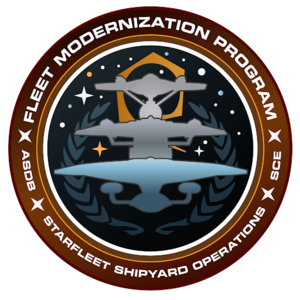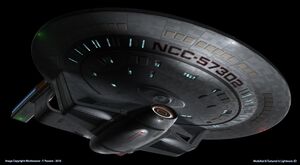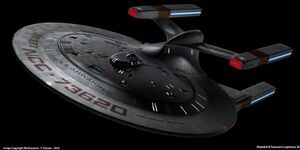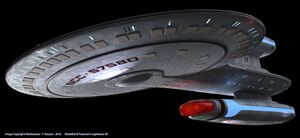Difference between revisions of "Fleet Modernization Program (2340s)"
CrimsonTacit (talk | contribs) (Created page with "The '''Fleet Modernization Program (FMP) of the 2340s and '50s''' was an initiative of the Advanced Starship Design Bureau, Starfleet Shipyard Operations, and the Starfleet Co...") |
CrimsonTacit (talk | contribs) |
||
| Line 12: | Line 12: | ||
The first and most visible part of the FMP was to settle on a common hull geometry and construction process for this new wave of ships. Rather than a circular primary hull (as was present on every previous major Starfleet class to that point), it was decided instead to use an elliptical design. This design would allow for more compartments in the primary hull to have viewports, the lack of which was a common complaint among crew members. In addition, the interlocking structural framework that was designed to support this elliptical structure would be the strongest space frame ever developed. The two ships in this phase would test competing primary hull designs: the Cheyenne a shape first debuted aboard the ''Constitution''-class with roughly symmetrical dorsal and ventral surfaces where the rim of the saucer was narrower than the center; and the ''Springfield'' a wholly-new design where the dorsal surface's taper was much more gradual, thus providing more space. | The first and most visible part of the FMP was to settle on a common hull geometry and construction process for this new wave of ships. Rather than a circular primary hull (as was present on every previous major Starfleet class to that point), it was decided instead to use an elliptical design. This design would allow for more compartments in the primary hull to have viewports, the lack of which was a common complaint among crew members. In addition, the interlocking structural framework that was designed to support this elliptical structure would be the strongest space frame ever developed. The two ships in this phase would test competing primary hull designs: the Cheyenne a shape first debuted aboard the ''Constitution''-class with roughly symmetrical dorsal and ventral surfaces where the rim of the saucer was narrower than the center; and the ''Springfield'' a wholly-new design where the dorsal surface's taper was much more gradual, thus providing more space. | ||
Engine systems would be enhanced versions of those used aboard the ''Ambassador''-class: the class-five warp core and fully-independent fusion-driven impulse engines, the latter of which were considered especially important, as designs derived from the ''Constitution''-class refit of the 2270s relied on a combination warp-impulse reaction assembly that had benefits when it came to fuel efficiency, but which led to an extremely complex internal reactor structure, as well as meaning that primary power failure meant the failure of both warp and impulse systems. | Engine systems would be enhanced versions of those used aboard the ''Ambassador''-class: the class-five warp core and fully-independent fusion-driven impulse engines, the latter of which were considered especially important, as designs derived from the ''Constitution''-class refit of the 2270s relied on a combination warp-impulse reaction assembly that had benefits when it came to fuel efficiency, but which led to an extremely complex internal reactor structure, as well as meaning that primary power failure meant the failure of both warp and impulse systems. To save on production expense, the warp coils in use aboard the two classes of Phase One were of a simplified design based on the general layout of ''Ambassador''-class warp nacelles, but with a squared-off design and truncated Bussard collectors. | ||
=== ''Springfield''-class Science Vessel (2345) === | === ''Springfield''-class Science Vessel (2345) === | ||
[[File:Springfieldclass.jpg|thumb|''The USS'' Chekov'', a'' Springfield''-class science vessel.'']] | [[File:Springfieldclass.jpg|thumb|''The USS'' Chekov'', a'' Springfield''-class science vessel.'']] | ||
''Main Article: [[Springfield Class|Springfield-class | ''Main Article: [[Springfield Class|Springfield-class science vessel]]'' | ||
The ''Springfield''-class starship was the first vessel to be produced as part of the FMP. It served as the testbed for one of two competing primary hull designs (the other being tested on the ''Cheyenne''-class) and of a modular pod system that served as the basis of the pod used later on the ''Nebula''-class. | The ''Springfield''-class starship was the first vessel to be produced as part of the FMP. It served as the testbed for one of two competing primary hull designs (the other being tested on the ''Cheyenne''-class) and of a modular pod system that served as the basis of the pod used later on the ''Nebula''-class. This class proved to be very successful, as it had a much higher standard of accommodation than either the ''Oberth''-class surveyor or ''Miranda''-class ships fitted for scientific duties, while also being a substantially lower resource investment than a heavy cruiser. The primary hull design pioneered on the ''Springfield'' was selected as the basic design for the ships in Phase Two. | ||
=== ''Cheyenne''-class Light Cruiser (2345) === | === ''Cheyenne''-class Light Cruiser (2345) === | ||
''Main Article'': ''[[Cheyenne Class|Cheyenne-class | ''Main Article'': ''[[Cheyenne Class|Cheyenne-class light cruiser]]'' | ||
[[File:Cheyenneclass.jpg|thumb|''A'' Cheyenne''-class light cruiser, the USS'' Awahanee''.'']] | |||
The ''Cheyenne''-class light cruiser was developed as a successor to the ''Constellation''-class cruiser, using the same four-nacelle design to increase endurance. This class was the first purpose-built class that could separate its primary and secondary hulls and reconnect them without starbase support or extended downtime, as well as an alternate primary hull arrangement. This design proved to be less successful than the ''Springfield''-class, though the saucer separation proof of concept would go on to pave the way for this functionality in many other classes in future decades. | |||
== Phase Two (2345-2352) == | |||
With the ''Springfield'' and ''Cheyenne''-class vessels in production and undergoing rigorous shakedown operations, Phase Two commenced with the ''Challenger''-class and ''New Orleans''-class designs, building off of what was learned in Phase One. As these two newer classes were designed, production on the Phase One vessels was ramped up, with many ''Miranda'' and ''Constellation''-class vessels being replaced by their successors. The priority for Phase Two was to lock down the warp coil design that would be incorporated aboard the ''Galaxy'' and ''Nebula''-class vessels, as well as their tactical systems. | |||
Still essentially based off of ''Ambassador''-class technology, the semi-toroidal warp coils developed in this phase were innovative in that each nacelle technically had two sets of coils, an upper and a lower set, which offered increases in efficiency and the ability to fine-tune warp fields to a degree that had never before been possible. They took the form of the characteristic rounded, elliptical cross-section nacelles that were the hallmark of ships designed in the 2350s. In addition, the characteristic navigational deflector design was also introduced in this phase. | |||
=== Challenger-class Scout / Courier (2350) === | |||
''Main Article: [[Challenger Class|Challenger-class scout]]'' | |||
[[File:Challengerclass.jpg|thumb|''The USS'' Buran'', a'' Challenger''-class scout that was lost in the Battle of Wolf 359.'']] | |||
The ''Challenger''-class was first launched in 2350 and employed a unique vertical stack arrangement of its warp nacelles, which were of the same semi-toroidal warp coil design that would eventually be used aboard the ''Galaxy'' and ''Nebula''. The advantages of this warp engine design were evident immediately in the ship's high top speed and maneuverability (thanks to thruster points being built into the structure of the nacelle itself). Another design feature tested aboard this class was yet another primary hull variation, in this case a symmetrical design with both the dorsal and ventral surfaces of the primary hull having a very gradual taper to maximize internal volume, to help nail down the final shape of the ''Galaxy'' and ''Nebula''-class saucer. In the end, it was decided that the design developed for the ''Springfield'' would go on to serve as the basis of the larger ships. The ''Challenger''-class itself enjoyed a moderate production run, but fewer of them were built than either the ''Springfield'' or ''New Orleans''-classes, due to these other two classes overlapping enough of their niche not to need many dedicated scouts or couriers. | |||
=== New Orleans-class Frigate (2352) === | |||
The ''New Orleans''-class was the testbed for the tactical systems that would be employed by the largest members of the FMP, namely the Type-X phaser array and burst-fire torpedo launcher. It also debuted the trademark elliptical-shaped deflector dish in use aboard the Phase Three classes, along with the overall hull geometry that would be used aboard the ''Galaxy''-class. This ship was the most effective and of all of the Phase One and Phase Two ships, and saw the largest production run. | |||
== Phase | In fact, as Phase Two wrapped up, it was envisioned that the ''New Orleans''-class might eventually make up the bulk of Starfleet's medium-sized ships. | ||
== Phase Three (2352-2368) == | |||
Phase Three saw the culmination of this program with the development of the ''Galaxy''-class explorer and ''Nebula''-class heavy cruiser, both of which would become iconic and long-serving starship classes. | |||
Revision as of 18:29, 15 March 2021
The Fleet Modernization Program (FMP) of the 2340s and '50s was an initiative of the Advanced Starship Design Bureau, Starfleet Shipyard Operations, and the Starfleet Corps of Engineers to develop a number of new starship classes to bring the advancements pioneered by the Ambassador-class into widespread use across Starfleet. This program would culminate in the development of the Galaxy-class explorer, first launched in the late 2350s. This program did not see full completion, as the Battle of Wolf 359 prompted a rapid pivot towards designs that were combat hardened in the late 2360s.
Background
By 2340, the Ambassador-class heavy cruiser had entered service as the largest and most powerful Federation starship ever constructed, with innovations in nearly every system, but especially the warp drive and defensive systems. These units were few and far between, though, with the fleet still being made up largely of Excelsior, Miranda, Constellation, and Oberth-class starships, the latter three of which relied on technology developed in the 2270s, even as more modern systems were added in piecemeal. They were built because they were proven, reliable designs, but they were starting to lag behind the technological innovations being developed by the Corps of Engineers, and there were limits to how many new technologies could successfully be integrated into these designs, especially considering that the Miranda's original configuration dated back to the 2250s!
Within Starfleet Command, there was extreme reluctance to change course, given that the majority of the fleet's senior leaders had cut their teeth on these legacy classes, and so it took concerted lobbying on the part of the Advanced Starship Design Bureau to receive permission to try something new: most of the time, Starfleet had preferred to develop a flagship class (such as the Constitution or Excelsior) first to allow other classes to be derived from these large, expensive designs, but the ASDB proposed doing the opposite instead. This time around, smaller classes would be developed that would incrementally introduce the innovations that would culminate in the flagship design: the Galaxy-class, which had long been in the works as the eventual Ambassador-class successor.
This program would develop a science vessel, a scout, a light cruiser, and a frigate, each of which would be modern, highly-capable, and superior to the aging starships that fulfilled those roles in the 2330s and 2340s. This would be Phases One and Two, with Phase Three being the construction of the Galaxy-class and Nebula-class starships which would supplant the Ambassador and Excelsior, resulting in a full complement of new starship designs on the books by 2360. Late in the process, it the California-class utility cruiser was added to Phase Three as well.
Phase One (2342-2345)
The first and most visible part of the FMP was to settle on a common hull geometry and construction process for this new wave of ships. Rather than a circular primary hull (as was present on every previous major Starfleet class to that point), it was decided instead to use an elliptical design. This design would allow for more compartments in the primary hull to have viewports, the lack of which was a common complaint among crew members. In addition, the interlocking structural framework that was designed to support this elliptical structure would be the strongest space frame ever developed. The two ships in this phase would test competing primary hull designs: the Cheyenne a shape first debuted aboard the Constitution-class with roughly symmetrical dorsal and ventral surfaces where the rim of the saucer was narrower than the center; and the Springfield a wholly-new design where the dorsal surface's taper was much more gradual, thus providing more space.
Engine systems would be enhanced versions of those used aboard the Ambassador-class: the class-five warp core and fully-independent fusion-driven impulse engines, the latter of which were considered especially important, as designs derived from the Constitution-class refit of the 2270s relied on a combination warp-impulse reaction assembly that had benefits when it came to fuel efficiency, but which led to an extremely complex internal reactor structure, as well as meaning that primary power failure meant the failure of both warp and impulse systems. To save on production expense, the warp coils in use aboard the two classes of Phase One were of a simplified design based on the general layout of Ambassador-class warp nacelles, but with a squared-off design and truncated Bussard collectors.
Springfield-class Science Vessel (2345)
Main Article: Springfield-class science vessel
The Springfield-class starship was the first vessel to be produced as part of the FMP. It served as the testbed for one of two competing primary hull designs (the other being tested on the Cheyenne-class) and of a modular pod system that served as the basis of the pod used later on the Nebula-class. This class proved to be very successful, as it had a much higher standard of accommodation than either the Oberth-class surveyor or Miranda-class ships fitted for scientific duties, while also being a substantially lower resource investment than a heavy cruiser. The primary hull design pioneered on the Springfield was selected as the basic design for the ships in Phase Two.
Cheyenne-class Light Cruiser (2345)
Main Article: Cheyenne-class light cruiser
The Cheyenne-class light cruiser was developed as a successor to the Constellation-class cruiser, using the same four-nacelle design to increase endurance. This class was the first purpose-built class that could separate its primary and secondary hulls and reconnect them without starbase support or extended downtime, as well as an alternate primary hull arrangement. This design proved to be less successful than the Springfield-class, though the saucer separation proof of concept would go on to pave the way for this functionality in many other classes in future decades.
Phase Two (2345-2352)
With the Springfield and Cheyenne-class vessels in production and undergoing rigorous shakedown operations, Phase Two commenced with the Challenger-class and New Orleans-class designs, building off of what was learned in Phase One. As these two newer classes were designed, production on the Phase One vessels was ramped up, with many Miranda and Constellation-class vessels being replaced by their successors. The priority for Phase Two was to lock down the warp coil design that would be incorporated aboard the Galaxy and Nebula-class vessels, as well as their tactical systems.
Still essentially based off of Ambassador-class technology, the semi-toroidal warp coils developed in this phase were innovative in that each nacelle technically had two sets of coils, an upper and a lower set, which offered increases in efficiency and the ability to fine-tune warp fields to a degree that had never before been possible. They took the form of the characteristic rounded, elliptical cross-section nacelles that were the hallmark of ships designed in the 2350s. In addition, the characteristic navigational deflector design was also introduced in this phase.
Challenger-class Scout / Courier (2350)
Main Article: Challenger-class scout
The Challenger-class was first launched in 2350 and employed a unique vertical stack arrangement of its warp nacelles, which were of the same semi-toroidal warp coil design that would eventually be used aboard the Galaxy and Nebula. The advantages of this warp engine design were evident immediately in the ship's high top speed and maneuverability (thanks to thruster points being built into the structure of the nacelle itself). Another design feature tested aboard this class was yet another primary hull variation, in this case a symmetrical design with both the dorsal and ventral surfaces of the primary hull having a very gradual taper to maximize internal volume, to help nail down the final shape of the Galaxy and Nebula-class saucer. In the end, it was decided that the design developed for the Springfield would go on to serve as the basis of the larger ships. The Challenger-class itself enjoyed a moderate production run, but fewer of them were built than either the Springfield or New Orleans-classes, due to these other two classes overlapping enough of their niche not to need many dedicated scouts or couriers.
New Orleans-class Frigate (2352)
The New Orleans-class was the testbed for the tactical systems that would be employed by the largest members of the FMP, namely the Type-X phaser array and burst-fire torpedo launcher. It also debuted the trademark elliptical-shaped deflector dish in use aboard the Phase Three classes, along with the overall hull geometry that would be used aboard the Galaxy-class. This ship was the most effective and of all of the Phase One and Phase Two ships, and saw the largest production run.
In fact, as Phase Two wrapped up, it was envisioned that the New Orleans-class might eventually make up the bulk of Starfleet's medium-sized ships.
Phase Three (2352-2368)
Phase Three saw the culmination of this program with the development of the Galaxy-class explorer and Nebula-class heavy cruiser, both of which would become iconic and long-serving starship classes.



